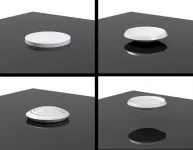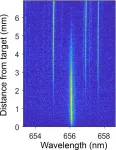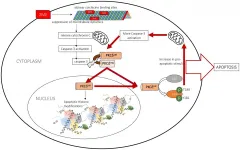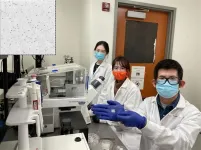(Press-News.org) COLUMBUS, Ohio - A new deep-learning model that can predict how human genes and medicines will interact has identified at least 10 compounds that may hold promise as treatments for COVID-19.
All but two of the drugs are still considered investigational and are being tested for effectiveness against hepatitis C, fungal disease, cancer and heart disease. The list also includes the approved drugs cyclosporine, an immunosuppressant that prevents transplant organ rejection, and anidulafungin, an antifungal agent.
The discovery was made by computer scientists, meaning much more work needs to be done before any of these medications would be confirmed as safe and effective treatments for people infected with SARS-CoV-2. But by using artificial intelligence to arrive at these options, the scientists have saved pharmaceutical and clinical researchers the time and money it would take to search for potential COVID-19 drugs on a piecemeal basis.
"When no one has any information on a new disease, this model shows how artificial intelligence can help solve the problem of how to consider a potential treatment," said senior author Ping Zhang, assistant professor of computer science and engineering and biomedical informatics at The Ohio State University.
The researchers noted in the paper that a few of the repurposing candidates the model generated have already been studied for their potential use in COVID-19 patients.
"Great minds think alike - some lead compounds identified by machine intelligence coincide with later discoveries by human intelligence," Zhang said.
The research is published today (Feb. 1) in Nature Machine Intelligence.
Zhang and colleagues had completed the model's design in May 2020, just as the first papers detailing how COVID-19 patients' genes responded to the virus were published. The new information provided an important test for the computer model, which the researchers call "DeepCE" - pronounced "Deep Sea."
To make predictions about how genes and medicines will interact and yield drug repurposing candidates, DeepCE relies on two primary sources of publicly available data: L1000, a National Institutes of Health-funded repository of human cell-line data showing how gene expression changes in response to drugs, and DrugBank, which contains information on the chemical structures and other details on about 11,000 approved and investigational drugs.
L1000 displays side-by-side cell-line comparisons of standard gene expression activity with gene expression changes produced by interactions with specific drugs. The cell lines represent diseases, such as melanoma, and organs, like kidneys and lungs. It is an ongoing project, with data being added as experiments in animals or humans supplement the gene expression profiles produced in cell-line experiments.
The Ohio State researchers trained the DeepCE model by running all of the L1000 data through an algorithm against specific chemical compounds and their dosages. To fill in data gaps, the model converts chemical compound descriptions into figures, allowing for automatic consideration of their separate components' effects on genes. And for genes not represented in L1000, the team used a deep learning approach called an "attention mechanism" to increase the model's "learned" sample of gene-chemical compound interactions, which improves the framework's performance.
"This way, the output demonstrates multitask learning - we can predict gene expression values for new chemicals not from one cell to one cell, but automatically predict the role of a drug on different cell lines and different genes," said Zhang, who leads the Artificial Intelligence in Medicine Lab and is a core faculty member in the Translational Data Analytics Institute at Ohio State. "We can use the computer to simulate drug-induced gene expression. This provides real value."
"The story should stop here - this is where we were during spring break. But then COVID-19 arrived, and we hoped our research could help, so we did a special case study for COVID-19 drug repurposing."
The team applied DeepCE's gene expression prediction matrix - focusing on data from lung and airway cell lines and the entire DrugBank catalog of compounds - to the genetic information provided from the early COVID-19 papers and additional government data. The COVID-19 data demonstrated how human gene expression had responded to being infected with SARS-CoV-2, creating a "disease signature."
"Based on the known gene expression changes that have occurred and been identified with known drugs, we apply that to the gene expression in question - in this case, compounds that are being studied but are not yet experimented in L1000. We put such predicted 'drug signatures' against the COVID-19 patient profiles on a population level," Zhang said.
"Once you can identify both signatures, the job is easy. Wherever we find the disease and a drug show opposite gene expression profiles, suggesting the drug would reverse the effects of the disease, you have found a drug that may treat the disease."
This model complements a drug-repurposing model Zhang described in a recent paper that simulates clinical trials using observational clinical data.
"I want to put together a research agenda using all the different data resources for drug repurposing and drug-disease associations from multiple perspectives and connect with researchers who can collaborate with us to find new drugs for diseases - including unknown diseases," Zhang said.
INFORMATION:
This work was supported by the National Institute of General Medical Sciences, the National Institute on Aging and the National Science Foundation. Co-authors are Thai-Hoang Pham and Jucheng Zeng from Ohio State and Yue Qiu and Lei Xie of the City University of New York.
Contact: Ping Zhang, Zhang.10631@osu.edu
Written by Emily Caldwell, Caldwell.151@osu.edu
Michelle O'Malley(link is external) has long been inspired by gut microbes. Since she began studying the herbivore digestive tract, the UC Santa Barbara chemical engineering professor has guided several students to their doctoral degrees, won early and mid-career awards (including a recognition from President Obama), attained tenure and advanced to the position of full professor. She even had three children along the way. A constant through it all: goat poop.
"This has been the longest single effort in my lab," said O'Malley, who with her research team way back in 2015 first embarked on an ambitious project to characterize gut microbes in large herbivores. The purpose? To understand how these animals manage, via their microbiomes, ...
Over the past century, a wide variety of models have emerged to explain the complex behaviours which unfold within atomic nuclei at low energies. However, these theories bring up deep philosophical questions regarding their scientific value. Indeed, traditional epistemological tools have been rather elaborated to account for a unified and stabilised theory rather than to apprehend a plurality of models. Ideally, a theory is meant to be reductionist, unifying and fundamentalist. In view of the intrinsic limited precision of their prediction and of the difficulty in assessing a priori their range of applicability, as well as of their specific and disconnected character, traditional ...
RESEARCH TRIANGLE PARK, N.C. -- Army-funded researchers discovered how to make materials capable of self-propulsion, allowing materials to move without motors or hands.
Researchers at the University of Massachusetts Amherst discovered how to make materials that snap and reset themselves, only relying upon energy flow from their environment. This research, published in Nature Materials and funded by the U.S. Army, could enable future military robots to move from their own energy.
"This work is part of a larger multi-disciplinary effort that seeks to understand biological and engineered impulsive systems that will lay the foundations for scalable methods for generating forces for mechanical action and energy storing structures and materials," said Dr. Ralph ...
WASHINGTON -- In a new study, investigators report an optimized approach to using laser-induced breakdown spectroscopy (LIBS) for analyzing hydrogen isotopes. Their new findings could enable improved rapid identification and measurement of hydrogen and other light isotopes that are important in nuclear reactor materials and other applications.
LIBS is promising for measuring hydrogen isotopes because it requires no sample preparation and data can be rapidly acquired with a relatively simple experimental setup. However, quantifying the concentration of hydrogen ...
Oncotarget published "The pro-apoptotic actions of 2-methoxyestradiol against ovarian cancer involve catalytic activation of PKCδ signaling" which reported that the authors have previously shown that a flaxseed-supplemented diet decreases both the incidence and severity of ovarian cancer in laying hens, also induces CYP1A1 expression in liver.
Recently, they have shown that as a biologically derived active component of flax diet, 2MeOE2 induces apoptosis in ovarian cancer cells which is partially dependent on p38 MAPK.
The objective of this Oncotarget study was to elucidate the molecular mechanism of actions of 2MeOE2, a known microtubule disrupting agent, in inducing apoptosis in ovarian tumors.
The objective of this ...
Each year, billions of tons of goods are transported globally using cargo containers. Currently, there are concerns that this immense volume of traffic could be exploited to transport illicit nuclear materials, with little chance of detection. One promising approach to combating this issue is to measure how goods interact with charged particles named muons - which form naturally as cosmic rays interact with Earth's atmosphere. Studies worldwide have now explored how this technique, named 'muon tomography,' can be achieved through a variety of detection technologies and reconstruction algorithms. In this article of EPJ Plus, a team headed by Francesco Riggi at the University of Catania, Italy, build on these results to develop a full-scale muon tomograph ...
As the numbers of those infected with COVID-19 has continued to climb, the desperate need for a vaccine was apparent. Even now with the invention and administration of several COVID-19 vaccinations, the question remains: How effective are these vaccines? HMNTL students Congnyu Che, Weijing Wang, and Nantao Li, also members of the ECE Nanosensors Group, along with Postdoctoral Researcher Bin Zhao and Professor Brian Cunningham have recently been published in Talanta journal for the development of a cost efficient COVID-19 antibody test.
"Compared with other detection methods, our method is a simple, 15-minute sample-to-answer test," says Zhao, a postdoctoral research associate and IGB Fellow. "It costs less ...
People who are unable to make their rent or mortgage payments sleep less than than their peers who don't have such problems, and those who are forced to move because of financial problems sleep even less, according to a new RAND Corporation study.
The study, which followed 1,046 people receiving welfare in California over several years, is the first to analyze the relationship between housing insecurity and sleep outcomes after controlling for sleep duration and sleep quality measured prior to experiences with housing insecurity.
The study found that people who were unable to make a rent or mortgage payment slept on average 22 fewer minutes a night than their peers who were able to make their rent or mortgage payments.
People who were ...
Richard Feynman, one of the most respected physicists of the twentieth century, said "What I cannot create, I do not understand". Not surprisingly, many physicists and mathematicians have observed fundamental biological processes with the aim of precisely identifying the minimum ingredients that could generate them. One such example are the patterns of nature observed by Alan Turing. The brilliant English mathematician demonstrated in 1952 that it was possible to explain how a completely homogeneous tissue could be used to create a complex embryo, and he did so using one of the simplest, most elegant mathematical models ever written. One of the results of such models is that the symmetry shown by a cell or a tissue can "break" under a set of conditions. However, ...
Theoretical physicists of the PRISMA+ Cluster of Excellence at Johannes Gutenberg University Mainz are working on a theory that goes beyond the Standard Model of particle physics and can answer questions where the Standard Model has to pass - for example, with respect to the hierarchies of the masses of elementary particles or the existence of dark matter. The central element of the theory is an extra dimension in spacetime. Until now, scientists have faced the problem that the predictions of their theory could not be tested experimentally. They have now overcome this problem in a publication in the current issue of the European Physical Journal C.
Already in the 1920s, in an attempt to unify the forces of gravity and electromagnetism, Theodor Kaluza and Oskar Klein speculated ...



